Testicle Implants
Testicle Implants Dr. Barry L. Eppley
TESTICLE IMPLANTS
Replacement vs Enhancement
The historic use of testicle implants is for reconstructive purposes to replace a lost testicle due to trauma, torsion, removal due to cancer or due to congenital absence. While this use for testicle implants still remains so currently, it bas become expanded for more aesthetic applications today as well. For the male that has had shrinking of their natural testicle size due to age or testosterone therapy or for the male with an average testicle size that desires an aesthetic enlargement, testicle implants are now available with innovative styles, sizes and material modifications to accomplish these aesthetic goals as well.
The importance in differentiating these two uses of testicle implants is that each one requires different implant features to be effective. Testicular implant replacement is the reconstruction of a missing or lost testicle. It is typically a single implant whose size goal is determined by the opposite existing testicle….which by definition makes it a normal size. (5.0cms or less) Testicular enhancement is taking a pair of existing testicles and increasing their size while they remain in place. This requires two implants whose size requirements are beyond what is seen in the normal development of most men. (greater than 5.0cms)
Saline vs Silicone Testicle Implants
![]()
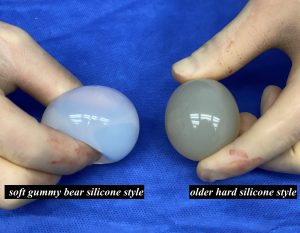 The first contemporary innovation in testicle implants relates to its material composition. Saline-filled testicle implants have been used for decades for reconstructive purposes in replacing the lost testicle. While perfectly safe and generally effective they have multiple undesirable properties including a very hard feel (water under pressure in a bag), the potential need for replacement due to failure (deflation due to disruption of the bag/shell of the implant) and limited size options. They also have a valve on one end for Intraoperative fill purposes which often becomes ingrown with scar tissue. Whether the implant is sewn in place or not the scar tissue ingrowth can act like suture fixation, giving him limited mobility.
The first contemporary innovation in testicle implants relates to its material composition. Saline-filled testicle implants have been used for decades for reconstructive purposes in replacing the lost testicle. While perfectly safe and generally effective they have multiple undesirable properties including a very hard feel (water under pressure in a bag), the potential need for replacement due to failure (deflation due to disruption of the bag/shell of the implant) and limited size options. They also have a valve on one end for Intraoperative fill purposes which often becomes ingrown with scar tissue. Whether the implant is sewn in place or not the scar tissue ingrowth can act like suture fixation, giving him limited mobility.
All of these saline implant features makes their use in testicle implant replacement less than ideal and completely unusable in the aesthetic testicular enhancement patient. Ultrasoft solid silicone implants are now available which have a more natural feel and better appearance. Due to their softer feel they could be called gummy bear testicle implants. Besides the more natural feel these implants will never need to be replaced due to device failure since they are solid and not fluid-filled..
![]() Standard solid ultrasoft testicle implants are available up to 5.0cms in size. (length : width ratio of 1.0 : 0.7) Beyond that size custom implants can be designed in any size and length:width ratio. Such custom testicle implants have been implanted up to 8.5cms in size with shapes that have ranged from a completely round (length = width) to a very oblong shape. (width 0.5 of length) In custom implants patients select and shape as long as I think they can be safely jmplanted.
Standard solid ultrasoft testicle implants are available up to 5.0cms in size. (length : width ratio of 1.0 : 0.7) Beyond that size custom implants can be designed in any size and length:width ratio. Such custom testicle implants have been implanted up to 8.5cms in size with shapes that have ranged from a completely round (length = width) to a very oblong shape. (width 0.5 of length) In custom implants patients select and shape as long as I think they can be safely jmplanted.
Testicular Enhancement Options
Testicular enhancement or enlargement refers to the male with his existing testicles who wants their size increased. To do so there are two techniques, a wraparound implant and the use of a side by side displacement implant. Each has their distinct advantages and disadvantages and one method is not good for everyone.
Wrap Around Testicle Implant
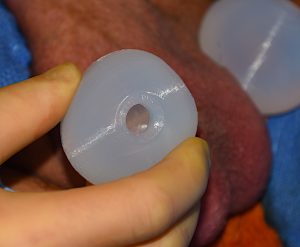
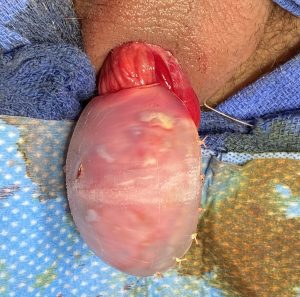 The wraparound method is the most intuitive approach to enlargement using the existing testicle as a platform to build on. It uses an implant that has either a 1/2 or 3/4 cup (infrequently used) or an implant with a hollow inner chamber into which the natural testicles fits. (most commonly used) It has an opening on one end which allows the exit of the neurovascular cord. The inner chamber of the implant is designed to be the natural size of the patient’s testicles and the outer diameter is the desired size enlargement goal. This wrap around concept has considerable appeal but there is always the risk of postoperative separation or pullout of the testicle from the implant. Despite various suturing technique during surgery to maintain the integrity of the implant-testicle union this potential complication has not been able to be completely avoided.
The wraparound method is the most intuitive approach to enlargement using the existing testicle as a platform to build on. It uses an implant that has either a 1/2 or 3/4 cup (infrequently used) or an implant with a hollow inner chamber into which the natural testicles fits. (most commonly used) It has an opening on one end which allows the exit of the neurovascular cord. The inner chamber of the implant is designed to be the natural size of the patient’s testicles and the outer diameter is the desired size enlargement goal. This wrap around concept has considerable appeal but there is always the risk of postoperative separation or pullout of the testicle from the implant. Despite various suturing technique during surgery to maintain the integrity of the implant-testicle union this potential complication has not been able to be completely avoided.
Side by Side Displacement Testicle Implants
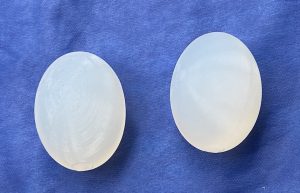 The side by side testicular enlargement technique uses a solid implant whose intent is to displace the natural testicles up and behind the implants. This makes the implant the visible testicular structure seen. This concept works as long as there is a significant size difference between the natural and implant testicle. A minimum of 50% and preferably a 75% increase in size difference is needed. (e.g., a 6.5cm implant with a 3.5cm natural testicle) Bedsides the larger size the implant has the advantage of not being tethered by a cord so they will naturally sit lower than the testicles. The major advantage to this testicular enlargement approach is that with a solid implant there is no risk of testicle-implant separation as can occur in the wrap around implant technique.
The side by side testicular enlargement technique uses a solid implant whose intent is to displace the natural testicles up and behind the implants. This makes the implant the visible testicular structure seen. This concept works as long as there is a significant size difference between the natural and implant testicle. A minimum of 50% and preferably a 75% increase in size difference is needed. (e.g., a 6.5cm implant with a 3.5cm natural testicle) Bedsides the larger size the implant has the advantage of not being tethered by a cord so they will naturally sit lower than the testicles. The major advantage to this testicular enlargement approach is that with a solid implant there is no risk of testicle-implant separation as can occur in the wrap around implant technique.
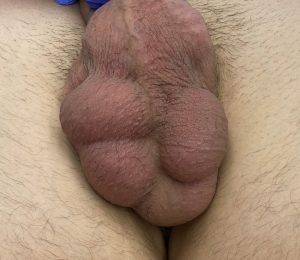 When adequate implant size is not chosen for the displacement technique, which occurred in this case when standard implants were used, all four scrotal occupants are seen. By definition the side by side displacement technique needs custom implants made.
When adequate implant size is not chosen for the displacement technique, which occurred in this case when standard implants were used, all four scrotal occupants are seen. By definition the side by side displacement technique needs custom implants made.
Scrotal Incisions
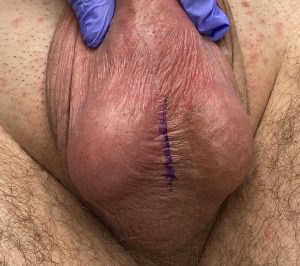
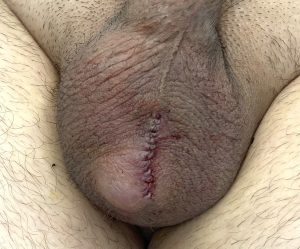 I prefer the use of a midline incision low on the scrotum for implant placement. While some patients may already have higher groin or scrotal incisions from prior surgery, I do not use them. Ensuring that the implant is positioned and stays low is done by coming from an inferior direction. The incisions are smaller than the diameter of the implants and with a multilayer closure there are no concerns about implant extrusion or wound breakdowns that could led to the need for implant removal. Its unique aesthetic complications is the risk of testicle reveal or one of the testicles protruding around or above the implants. This has been a fairly uncommon postoperative issue and isn avoided by ensuring a large enough implant size.
I prefer the use of a midline incision low on the scrotum for implant placement. While some patients may already have higher groin or scrotal incisions from prior surgery, I do not use them. Ensuring that the implant is positioned and stays low is done by coming from an inferior direction. The incisions are smaller than the diameter of the implants and with a multilayer closure there are no concerns about implant extrusion or wound breakdowns that could led to the need for implant removal. Its unique aesthetic complications is the risk of testicle reveal or one of the testicles protruding around or above the implants. This has been a fairly uncommon postoperative issue and isn avoided by ensuring a large enough implant size.
Testicle Implant Fixation
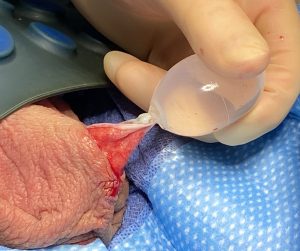
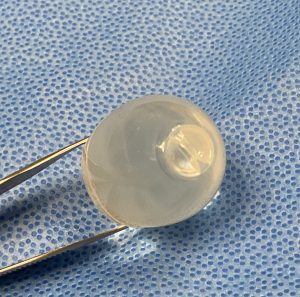 Testicle implants have a history of being sutured into place and I still see it being done today. I see no purpose to this technical step and it often creates a tethering effect or a palpable knot where the suture is. Even if the implant is not sutured into place the valve on the ned of a saline implant allows tissue ingrowth which create an adhesion very similar to it being sutured,. While the natural testicle may be attached by a neurovascular cord, which has specific biologic reasons for being so, this does not apply to an implant. An implant should be allowed to hang and move freely.
Testicle implants have a history of being sutured into place and I still see it being done today. I see no purpose to this technical step and it often creates a tethering effect or a palpable knot where the suture is. Even if the implant is not sutured into place the valve on the ned of a saline implant allows tissue ingrowth which create an adhesion very similar to it being sutured,. While the natural testicle may be attached by a neurovascular cord, which has specific biologic reasons for being so, this does not apply to an implant. An implant should be allowed to hang and move freely.
Testicle Implant Sizes
The standard sizes for testicle implants is based on the origin of their development, and to which they are still used today, as replacement for a lost testicle.Thus the available off-the-shelf size options are within the normal range of natural testicles. (3.0 to 5.0) But for men seeking testicular enhancement their aesthetic needs go above these sizes and custom implant designing is used to create such enhancement options.
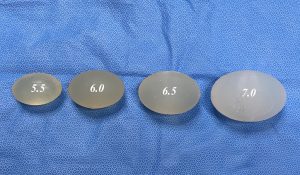 In custom testicle implants any size and dimensions of the implant can be designed and manufactured. But the typical size ranges are from 5.5cm to 7.5cm with implants volumes of 60cc to 110ccs. A few patients have had implants up to 8.5ccs but this usually means the patient has a large body frame and scrotum so that size, big as it is, is not disproportionate as it may seem.
In custom testicle implants any size and dimensions of the implant can be designed and manufactured. But the typical size ranges are from 5.5cm to 7.5cm with implants volumes of 60cc to 110ccs. A few patients have had implants up to 8.5ccs but this usually means the patient has a large body frame and scrotum so that size, big as it is, is not disproportionate as it may seem.
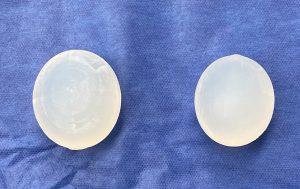 The typical shape of custom testicle implants is based on a standard ratio of the width being 0.7 to that of its length. While this is fine for most patients some request different length:width ratios as well as the addition of the ‘3rd dimension’ to the implant design which is the addition of two widths at 90m degree from each other in the top view. Implants can also be made with asymmetric sizes with one side being slightly bigger or smaller than the other.
The typical shape of custom testicle implants is based on a standard ratio of the width being 0.7 to that of its length. While this is fine for most patients some request different length:width ratios as well as the addition of the ‘3rd dimension’ to the implant design which is the addition of two widths at 90m degree from each other in the top view. Implants can also be made with asymmetric sizes with one side being slightly bigger or smaller than the other.
Custom Testicle Implant Design Innovations
One of the benefits of custom testicle implant designs is that the softness of the implant material, known as durometer, can be adjusted to the level off softness needed. As a general rule most custom testicle implants are made of an extra extra soft (XXS) silicone material which essentially feels like a gummy bear candy. This is usually adequate softness for most patients.
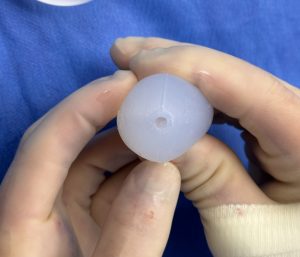
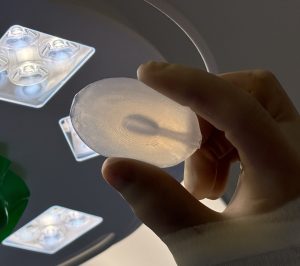 But as implant sizes become bigger this means more implant material. And even XXS implant material can feel As a result even an XXS implant can feel firmer than one would like in very large sizes. An innovative method to ensure that even the largest testicle implant feels as soft as possible is to design it with a hollow inner chamber. This is done by having a small entrance on one end of the implant which leads to a small central chamber. This is somewhat similar to the passageways leading to the rooms in the Great Pyramid. This works for increased softness by reducing the amount of material inside the implant which makes easier to compress. (i.e., feel softer)
But as implant sizes become bigger this means more implant material. And even XXS implant material can feel As a result even an XXS implant can feel firmer than one would like in very large sizes. An innovative method to ensure that even the largest testicle implant feels as soft as possible is to design it with a hollow inner chamber. This is done by having a small entrance on one end of the implant which leads to a small central chamber. This is somewhat similar to the passageways leading to the rooms in the Great Pyramid. This works for increased softness by reducing the amount of material inside the implant which makes easier to compress. (i.e., feel softer)
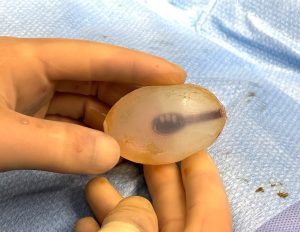 One other benefit of an internal chamber with external access is that it can have antibiotic materials put inside the implant. This serves as an extra measure of infection prevention.
One other benefit of an internal chamber with external access is that it can have antibiotic materials put inside the implant. This serves as an extra measure of infection prevention.
Custom Testicle Implant Results (Long Term Appearance)
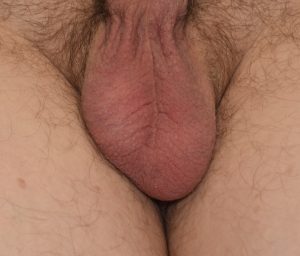
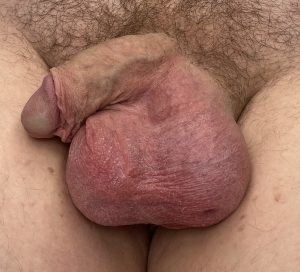
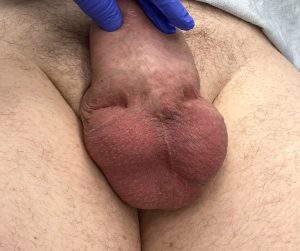
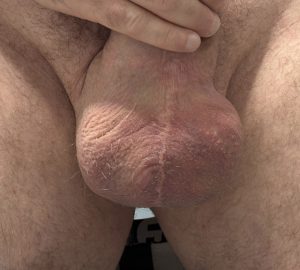
When much larger implants sizes compared to the natural size off the testicles, for which the scrotum has been designed to accommodate, there is going to be an immediate ‘high and tight’ feeling. So the important question of do they ever drop and feel natural is common. The answer is they do but it will take time. Fortunately the scrotal tissues are thin so they have a great capacity to stretch. Also since the implants are placed through a low midline scrotal incision and are not sutured into place they are best positioned to develop that eventual drop to a more natural position. (although it is important to remember there is nothing natural with testicle implants at this size)

North Meridian Medical Building
Address:
12188-A North Meridian St.
Suite 310
Carmel, IN 46032
Contact Us:
Phone: (317) 706-4444
WhatsApp: (317) 941-8237
